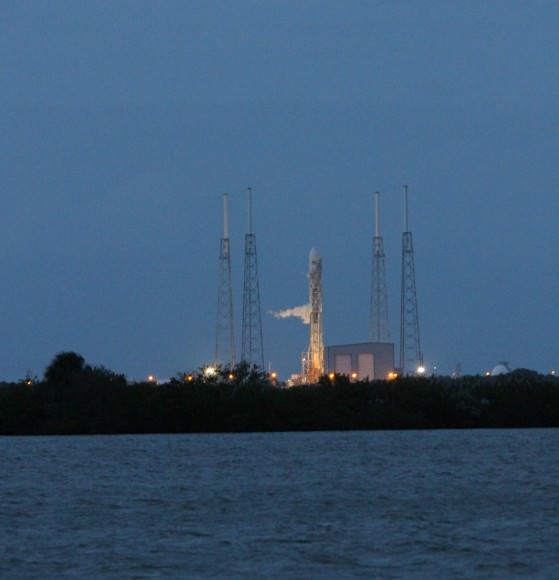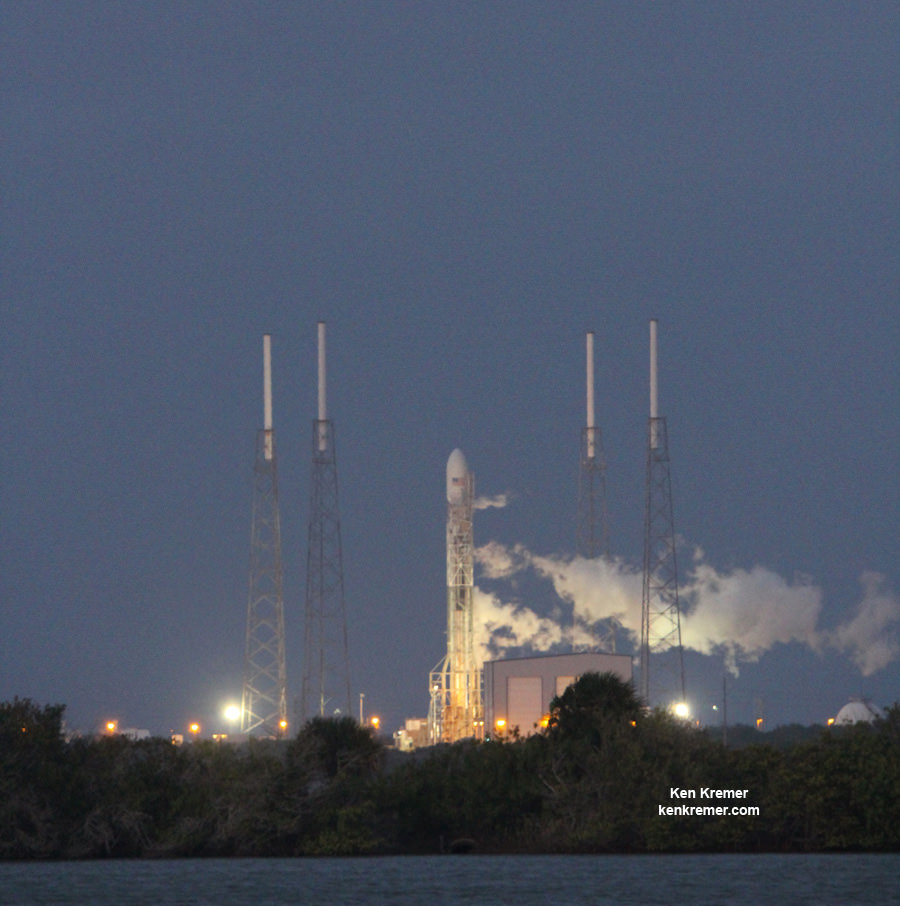CAPE CANAVERAL, FL – Today (Dec. 3) marks the 3rd attempt by SpaceX to launch the maiden flight of their significantly upgraded Falcon 9 rocket with the SES-8 telecommunications satellite – following the Nov. 28 ‘Thanksgiving = Spacegiving Day’ scrub due to an aborted 1st stage engine firing in progress.
And the stakes could not be higher for the future of SpaceX – with the firms future launch manifest worth billions of dollars riding on the success of today’s liftoff from Cape Canaveral Air Force Station, Florida.
In an unprecedented launch event for SpaceX, the upper stage engine on the next generation Falcon 9 booster absolutely must restart in flight for a second time in order for the commercial SES-8 payload to be delivered to geostationary transfer orbit (GTO).
Blastoff from Cape Canaveral’s seaside Space Launch Complex 40 is set for 5:41 p.m. EST (2241 GMT).
The Thanksgiving Day launch was aborted by the computers when the Marlin engines thrust failed to build up as fast as planned.
The weather forecast currently shows a 90% chance of favorable conditions at liftoff time according to Air Force meteorologists. The only concern is for winds.

The launch of SES-8 is a milestone marking the first ever attempt by SpaceX to place a satellite into the geostationary orbit replete with numerous high value commercial satellites. This is the doorway to the future profitability of SpaceX.
“I don’t want to tempt fate, but I think it’s going to have a pretty significant impact on the world launch market and on the launch industry because our prices are the most competitive of any in the world,” said SpaceX CEO and chief designer Elon Musk at a prelaunch briefing for media including Universe Today in Cocoa Beach, FL.
For the mission to be declared a success, the upper stage engine must reignite precisely as planned about 27 minutes after liftoff and burn for approximately 1 minute to successfully propel SES-8 into the propel orbit about 33 minutes after launch.

“Whether or not this launch is successful, I’m confident we will certainly make it on some subsequent launch,” said Musk.
“This is really rocking the industry. Everybody has to look out,” said Martin Halliwell, SES chief technical officer, who joined Musk at the prelaunch meeting.
The upgraded Falcon 9 will also be the launcher utilized for the manned SpaceX Dragon capsules launching to the ISS sometime later this decade!
And the very next satellite set for launch by SpaceX later in December – Thaicom 6- is essentially already waiting at the door to the onramp to space.
SpaceX plans a live broadcast of the Falcon 9 liftoff from pad 40 on Cape Canaveral Air Force Station, FL beginning at 5 p.m. EST.
It can be viewed here: www.spacex.com/webcast
The show will feature commentary about the Falcon 9 rocket and launch sequences and the SES-8 commercial satellite from SpaceX corporate headquarters in Hawthorne, CA.
The Falcon 9/SES-8 launch window extends for 86 minutes until 7:07 p.m. EST.
The 3,138 kg (6,918 lbs) SES-8 satellite is a hybrid Ku- and Ka-band spacecraft that will provide TV and communications coverage for the South Asia and Asia Pacific regions.
This mighty new version of the Falcon 9 dubbed v1.1 is powered by a cluster of nine of SpaceX’s new Merlin 1D engines that are about 50% more powerful compared to the standard Merlin 1C engines. The nine Merlin 1D engines 1.3 million pounds of thrust at sea level that rises to 1.5 million pounds as the rocket climbs to orbit
The Merlin 1-D engines are arrayed in an octaweb layout for improved efficiency.
Therefore the upgraded Falcon 9 can boost a much heavier cargo load to the ISS, low Earth orbit, geostationary orbit and beyond.
The next generation Falcon 9 is a monster. It measures 224 feet tall and is 12 feet in diameter. That compares to 13 stories for the original Falcon 9.
Stay tuned here for continuing SpaceX & MAVEN news and Ken’s SpaceX launch reports from on site at Cape Canaveral & the Kennedy Space Center press site.


good luck Space X
slightly annoying that the author gives new rocket’s height in feet and old rocket’s height in “stories”. how is that a comparison? you changed the units!